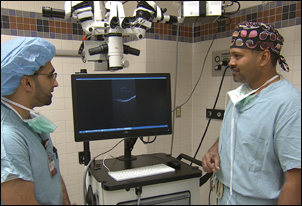PUBLICATION EXCLUSIVE: Real-time imaging adds interactive dimension to vitreoretinal, surgery training
First introduced in the early 1990s, OCT is a noninvasive imaging technique that obtains high-resolution, cross-sectional images of the retina and other ophthalmic tissues.
In recent years, this technology has transitioned from being only available in the clinic to being able to be utilized in the operating room. Intraoperative OCT has allowed ophthalmologists to access real-time imaging of vitreoretinal surgery for the first time, adding a new dimension to surgery and education, according to a 2016 study published in Eye (London) by Justis P. Ehlers, MD.
There are several FDA-approved systems with optional add-ons to improve performance. Companies such as Leica, Carl Zeiss Meditec and Haag-Streit have developed systems for ophthalmologists to obtain and utilize real-time intraoperative images of their procedures.
Improvements in imaging
Since the early 2000s, technology has been developed to gather clinical images of the retina, such as fluorescein angiography, fundus photography, widefield imaging, OCT and OCT angiography, OSN Retina/Vitreous Board Member Seenu M. Hariprasad, MD, said.

Image: Hariprasad SM
However, when performing vitreoretinal surgery, there is a “complete disconnect” with these useful in-office technologies, he said.
“When I take a patient to the operating room, it’s a complete digital cutoff. I have a few still images that I printed out in my office to take to the operating room, but they’re not dynamic, but rather just a rough indication of what’s going on. It’s not live. It’s not dynamic. It’s not that useful beyond the ability to confirm that the patient has a certain diagnosis,” he said.
But now, with the development of intraoperative OCT systems, Hariprasad said ophthalmologists have the ability to image the eye in “real time” to assist the surgeon in various ways and enhance the educational experience for trainees.
An added dimension
The technology adds another dimension to vitreoretinal surgery and can help the surgeon in various ways. For example, during a tractional retinal detachment case, the EnFocus Leica intraoperative OCT unit can help delineate tissue planes and identify point adhesions between pathologic membranes and the retina, Hariprasad said.
“These technologies bring OCT imaging technology into the operating room setting. When I’m doing vitrectomy surgery for an epiretinal membrane, for example, and I want to take an optical slice of the retina, I just click a button and the machine starts scanning. I can see the epiretinal membrane as I would in my office. As I pinch the membrane to peel it away with my forceps, I can in real time see if I am applying too much traction to the retina as I peel the membrane off of the surface of the retina. After membrane peeling is completed, I can reimage to see whether I completely peeled the epiretinal membrane. Intraoperative OCT adds another dimension to surgery,” Hariprasad said.
- Click here to read the full publication exclusive, Cover Story, published in Ocular Surgery News U.S. Edition, August 10, 2017.
